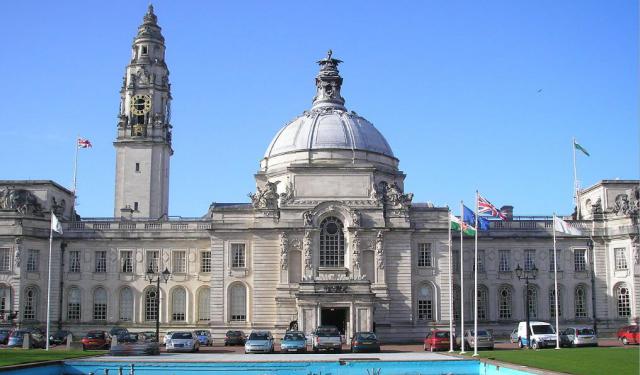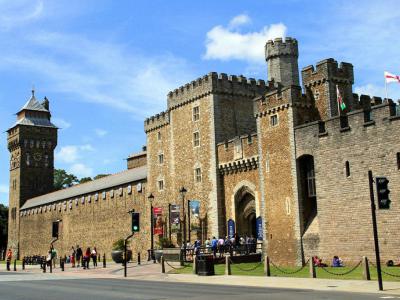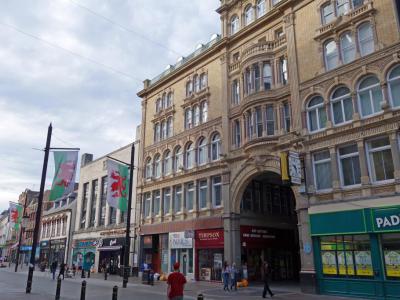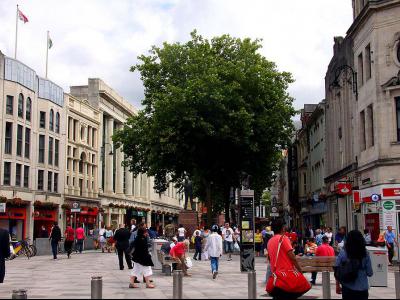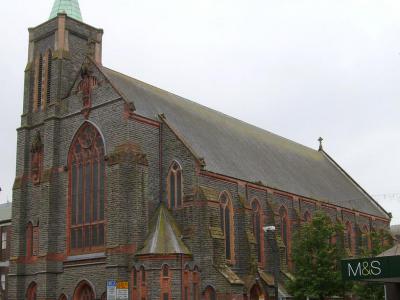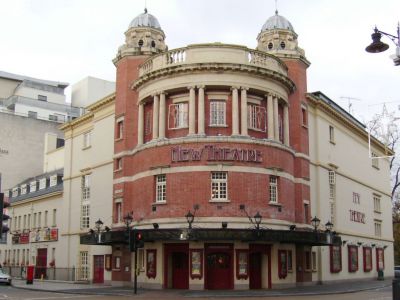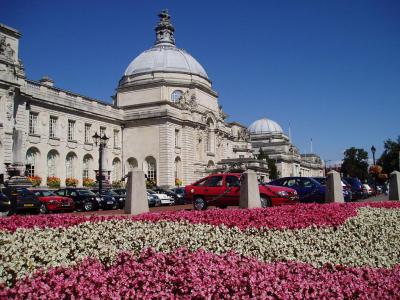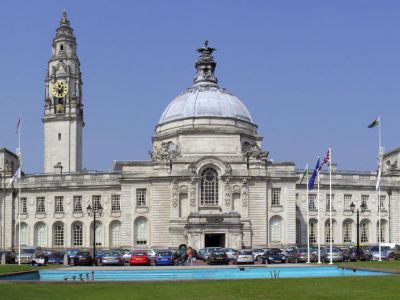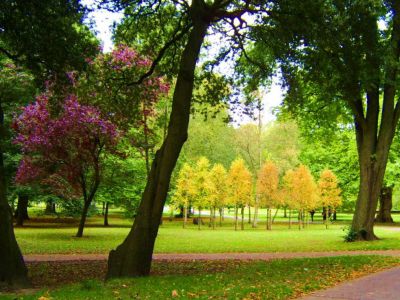Cardiff Introduction Walking Tour (Self Guided), Cardiff
"Cardiff" came from the Welsh word "Caer-Taff" which means "Fort on the river Taff." Cardiff cannot be separated from the Cardiff Castle nor the castle from the city. People had been living in the neighborhood of Cardiff on the banks of the Taff when the Romans arrived and built a fort in 55 AD.
The fortification was strategically located. It was possible to control the harbor on the Bristol Channel and the vital coast road alongside the Taff. However as the Roman Empire faded, the square-shaped fort was abandoned in the 4th century AD.
Cardiff was not officially founded until the bumptious arrival of Robert Fitzhamon, a mate of William the Conqueror. In 1081 Fitzhamon conquered Glamorgan and the Roman ruin of Caer-Taff. He built a wooden castle inside the old walls of the Roman fort.
The fort was rebuilt in stone in the 12th century. The town was small, even for Wales. It huddled in the shadow of the castle. The garrison provided protection for the residents and a market for goods produced in the town. Market fairs were held twice a year.
The Lordship of Cardiff and Glamorgan were passed about among Richard III, Henry VII and at last Henry VIII. In 1550 the lordship and castle were given to the Herbert family of South Wales by Edward VI. In 1776 it passed by marriage to the marquesses of Bute.
The Bute family had a strong influence on the growth and development of Cardiff during the Industrial Revolution and into the 20th century. They provided land to the town to build the Civic Center. The castle and its parkland were donated to the City of Cardiff in 1947.
Once a Norman stronghold for war, the Cardiff Castle today is a venue for happier events. The Edwardian buildings in the civic center of Cathays Park are surrounded by ornamental gardens. There is the City Hall, the law courts. The National Museum of Wales has one of the largest collections of impressionist paintings other than Paris.
The National History Museum is an open air museum with 40 to 50 representative buildings of Welsh history. The Old Library is home to the Cardiff Story Museum. Bute park has plenty of green, including acres of formerly private gardens.
There are many things to learn about the City on the River Taff. Come and see.
The fortification was strategically located. It was possible to control the harbor on the Bristol Channel and the vital coast road alongside the Taff. However as the Roman Empire faded, the square-shaped fort was abandoned in the 4th century AD.
Cardiff was not officially founded until the bumptious arrival of Robert Fitzhamon, a mate of William the Conqueror. In 1081 Fitzhamon conquered Glamorgan and the Roman ruin of Caer-Taff. He built a wooden castle inside the old walls of the Roman fort.
The fort was rebuilt in stone in the 12th century. The town was small, even for Wales. It huddled in the shadow of the castle. The garrison provided protection for the residents and a market for goods produced in the town. Market fairs were held twice a year.
The Lordship of Cardiff and Glamorgan were passed about among Richard III, Henry VII and at last Henry VIII. In 1550 the lordship and castle were given to the Herbert family of South Wales by Edward VI. In 1776 it passed by marriage to the marquesses of Bute.
The Bute family had a strong influence on the growth and development of Cardiff during the Industrial Revolution and into the 20th century. They provided land to the town to build the Civic Center. The castle and its parkland were donated to the City of Cardiff in 1947.
Once a Norman stronghold for war, the Cardiff Castle today is a venue for happier events. The Edwardian buildings in the civic center of Cathays Park are surrounded by ornamental gardens. There is the City Hall, the law courts. The National Museum of Wales has one of the largest collections of impressionist paintings other than Paris.
The National History Museum is an open air museum with 40 to 50 representative buildings of Welsh history. The Old Library is home to the Cardiff Story Museum. Bute park has plenty of green, including acres of formerly private gardens.
There are many things to learn about the City on the River Taff. Come and see.
How it works: Download the app "GPSmyCity: Walks in 1K+ Cities" from Apple App Store or Google Play Store to your mobile phone or tablet. The app turns your mobile device into a personal tour guide and its built-in GPS navigation functions guide you from one tour stop to next. The app works offline, so no data plan is needed when traveling abroad.
Cardiff Introduction Walking Tour Map
Guide Name: Cardiff Introduction Walking Tour
Guide Location: Wales » Cardiff (See other walking tours in Cardiff)
Guide Type: Self-guided Walking Tour (Sightseeing)
# of Attractions: 9
Tour Duration: 2 Hour(s)
Travel Distance: 2.8 Km or 1.7 Miles
Author: Nick
Sight(s) Featured in This Guide:
Guide Location: Wales » Cardiff (See other walking tours in Cardiff)
Guide Type: Self-guided Walking Tour (Sightseeing)
# of Attractions: 9
Tour Duration: 2 Hour(s)
Travel Distance: 2.8 Km or 1.7 Miles
Author: Nick
Sight(s) Featured in This Guide:
- Cardiff Castle
- Cardiff Central Market
- The Hayes
- Queen Street
- Cardiff Metropolitan Cathedral
- The New Theater
- National Museum Cardiff
- City Hall
- Bute Park
1) Cardiff Castle (must see)
Castle building in Wales started early. The future site of Cardiff Castle was a Roman defensive encampment in 55 AD. By the 3rd century a new fortification emerged. It was Roman again, 635 feet by 603 feet and made from limestone. It was abandoned in the 4th century.
By 1080, forces of William the Conqueror had reached into South Wales. The Normans liked forts. William is said to have built the original Cardiff Castle while returning from a pilgrimage to Saint David's in 1081. The castle was close to the sea and easily defended.
The 12th century was the time of the Anarchy, with civil strife and bloodshed. The castle passed from Henry II to to the de Clares. From the de Clares it went to the Despensers. During the Wars of the Roses, title passed at last to Prince Henry, soon to be Henry VIII. In 1776 the Bute family acquired the Castle.
In 1868 Architect William Burges was given the job of remodeling. Work started with the 150 foot ashlar stone Clock Tower. It holds a suite of four rooms. The rooms are opulently decorated and gilded. There are murals of the seasons, legends and myths. The floor is a mosaic of the world.
The Guest Tower, the Arab Room, the Chaucer Room, the Nursery, the Library, the Banqueting Hall and bedrooms had been constructed in the 18th century. The Bute Tower includes a roof garden with a sculpture of the Madonna and Child.
Burges redid the castle in a Gothic Revival style. Extensive landscaping was done around the castle. During the 20th century work continued. The Bute lands and commercial holdings were sold off. After World War II the castle belonged to the City of Cardiff.
Today the castle is a tourist attraction and a venue for events, concerts and festivals.
By 1080, forces of William the Conqueror had reached into South Wales. The Normans liked forts. William is said to have built the original Cardiff Castle while returning from a pilgrimage to Saint David's in 1081. The castle was close to the sea and easily defended.
The 12th century was the time of the Anarchy, with civil strife and bloodshed. The castle passed from Henry II to to the de Clares. From the de Clares it went to the Despensers. During the Wars of the Roses, title passed at last to Prince Henry, soon to be Henry VIII. In 1776 the Bute family acquired the Castle.
In 1868 Architect William Burges was given the job of remodeling. Work started with the 150 foot ashlar stone Clock Tower. It holds a suite of four rooms. The rooms are opulently decorated and gilded. There are murals of the seasons, legends and myths. The floor is a mosaic of the world.
The Guest Tower, the Arab Room, the Chaucer Room, the Nursery, the Library, the Banqueting Hall and bedrooms had been constructed in the 18th century. The Bute Tower includes a roof garden with a sculpture of the Madonna and Child.
Burges redid the castle in a Gothic Revival style. Extensive landscaping was done around the castle. During the 20th century work continued. The Bute lands and commercial holdings were sold off. After World War II the castle belonged to the City of Cardiff.
Today the castle is a tourist attraction and a venue for events, concerts and festivals.
2) Cardiff Central Market
Cardiff market, also called Cardiff Central Market or the Market Building, is located on Saint Mary Street in Cardiff. The Market is an imposing Victorian building with a glass roof. There are two entrances, one from Saint Mary Street and the other from Trinity Street.
The original site of the Market was the Cardiff jail and gallows. Richard Lewis, also known as Dic Penderyn, was hanged there in 1831, for allegedly killing a soldier with a bayonet. Dic Penderyn was a Welsh coal miner who lived in Merthyr Tydfil and participated in the Merthyr Rising of 3 June 1831. However, there was insufficient evidence to prove that he committed the killing, and more than 11,000 people signed a petition for his release. After his death he was treated as a martyr in Merthyr and across Wales.
Back in the old days, public execution was gruesome lunchtime entertainment. Happily, the market replaced the jail. The market opened in May, 1891. It was designed by Borough Surveyor Willam Harpur.
Actually, aside from the gallows, a farmers' market had existed on the site since the 1700s. There are two floors for shopping: a ground floor and a balcony floor that wraps around the inside of the building. A large clock replaced the original clock at the High Street entrance in 1963.
It is a very lively market of local small businesses offering everything from Welsh cuisine, street food, clothing, records, fruit and vegetables and even a psychic medium. Ashton's Fishmongers have traded here since 1866. It is a happy place for strolling and snacking.
The original site of the Market was the Cardiff jail and gallows. Richard Lewis, also known as Dic Penderyn, was hanged there in 1831, for allegedly killing a soldier with a bayonet. Dic Penderyn was a Welsh coal miner who lived in Merthyr Tydfil and participated in the Merthyr Rising of 3 June 1831. However, there was insufficient evidence to prove that he committed the killing, and more than 11,000 people signed a petition for his release. After his death he was treated as a martyr in Merthyr and across Wales.
Back in the old days, public execution was gruesome lunchtime entertainment. Happily, the market replaced the jail. The market opened in May, 1891. It was designed by Borough Surveyor Willam Harpur.
Actually, aside from the gallows, a farmers' market had existed on the site since the 1700s. There are two floors for shopping: a ground floor and a balcony floor that wraps around the inside of the building. A large clock replaced the original clock at the High Street entrance in 1963.
It is a very lively market of local small businesses offering everything from Welsh cuisine, street food, clothing, records, fruit and vegetables and even a psychic medium. Ashton's Fishmongers have traded here since 1866. It is a happy place for strolling and snacking.
3) The Hayes
In the center of Cardiff are three shopping streets: Queen Street, Saint Mary Street and the Hayes. The Hayes is almost entirely pedestrianized. Going southward to the east end of the City Center one encounters the Hayes Island Snack Bar. Doesn't sound like much, but wait, this snack bar has a history and a reputation.
The snack bar was originally built as a parcel depot for Cardiff Corporation Tramways in 1911. Horse trams were used in the city until 1903 when Cardiff switched to electric trams. The depot kiosk was closed in 1942 and reopened in 1948 as a snack bar. It is the oldest snack bar in Wales. It is "a rare survivor of Cardiff's tramway system."
At the north end of the Hayes is the Old Library. From 1882 until 1988 it was known as the Cardiff Free Library, Museum and Schools for Science and Art. The new permanent Cardiff Central Library sits at the opposite end of the Hayes.
Victorian glass covered shopping arcades are especially peculiar to Cardiff. The Royal Arcade and the Morgan Arcade each have entrances on the Hayes. The Hayes shopping arcades and shops have undergone massive renovations.
The renovated Hayes is memorialized in an 82 foot high stainless steel sculpture called "Alliance." The sculpture is a stainless steel enameled arrow column.
On Hayes, one can find some of the best shops and restaurants in the city.
The snack bar was originally built as a parcel depot for Cardiff Corporation Tramways in 1911. Horse trams were used in the city until 1903 when Cardiff switched to electric trams. The depot kiosk was closed in 1942 and reopened in 1948 as a snack bar. It is the oldest snack bar in Wales. It is "a rare survivor of Cardiff's tramway system."
At the north end of the Hayes is the Old Library. From 1882 until 1988 it was known as the Cardiff Free Library, Museum and Schools for Science and Art. The new permanent Cardiff Central Library sits at the opposite end of the Hayes.
Victorian glass covered shopping arcades are especially peculiar to Cardiff. The Royal Arcade and the Morgan Arcade each have entrances on the Hayes. The Hayes shopping arcades and shops have undergone massive renovations.
The renovated Hayes is memorialized in an 82 foot high stainless steel sculpture called "Alliance." The sculpture is a stainless steel enameled arrow column.
On Hayes, one can find some of the best shops and restaurants in the city.
4) Queen Street
Queen Street is a curving, mostly pedestrianized shopping street in the center of Cardiff. Retractable barriers bar motor vehicles except for city trams from the area. The street extends by the side of the Castle Quarter. It connects Cardiff Castle to the A4161 in the east. It is lined with well known shopping outlets along its length.
Marks & Spencer dominates its own quarter. There are food halls offering almost anything edible, including champagne, crepes and compotes. JD Sports features footwear and sports gear. Topshop and Zara have things to wear. There are gastropubs and several international eateries. Lunch, anyone?
Capitol Shopping Centre commands an enormous retail space at one end of Queen Street. The recently modernized Centre homes in on surfer gear, fashion, home furnishings and jewelry. For the fast shoppers there are a range of fast food options.
Queens Arcade should not go unmentioned. It is grafted onto the large Saint David's Dewi Sant compound. It has a variety of not too elite shops and a casual ambience. It is, in fact, a connecting mall between Queen Street and Working Street. In general, shopping at Queens Arcade is a bit less expensive than neighboring Saint David's.
Marks & Spencer dominates its own quarter. There are food halls offering almost anything edible, including champagne, crepes and compotes. JD Sports features footwear and sports gear. Topshop and Zara have things to wear. There are gastropubs and several international eateries. Lunch, anyone?
Capitol Shopping Centre commands an enormous retail space at one end of Queen Street. The recently modernized Centre homes in on surfer gear, fashion, home furnishings and jewelry. For the fast shoppers there are a range of fast food options.
Queens Arcade should not go unmentioned. It is grafted onto the large Saint David's Dewi Sant compound. It has a variety of not too elite shops and a casual ambience. It is, in fact, a connecting mall between Queen Street and Working Street. In general, shopping at Queens Arcade is a bit less expensive than neighboring Saint David's.
5) Cardiff Metropolitan Cathedral
It is an ill wind that blows no one any good. Poverty and the troubles in Ireland in the 19th century caused a sudden increase of immigrants from Ireland to Cardiff looking for work. The number of Catholics in Cardiff increased dramatically. They needed a church.
The original Saint David's was built in 1842. The cost was over two thousand pounds. Funds raised in Ireland and Wales were increased by donations from Lady Catherine Eyre of Bath. The church was located on David Street and it was named for Saint David, the patron saint of Wales.
The new church was built in 1887 by Pugin & Pugin Architects. It became the seat of the Catholic Archbishop of Cardiff in 1916. The church was elevated to cathedral status in 1920. It is located on Charles Street. It is one of three Roman Catholic Cathedrals in the United Kingdom. It is also famous for its choir school.
The Cathedral was basically destroyed in World War II when an incendiary bomb penetrated the roof. It was rebuilt and restored in the 1950s. It reopened in 1959. The restoration work was carried out by Bates, Son & Price.
The reborn cathedral has new hammerbeam roof trusses over the nave. It is made from Pennant sandstone in an Early English style. It has a four-stage tower and a high five light window. The beam roof covers the seven bay nave. The nave has side chapels and confessionals. There are great arches and a two bay choir under a circular window.
Statues of martyrs John Lloyd and Philip Evans of Cardiff are here. A late Victorian stained glass window shows the Immaculate Conception witnessed by the Popes.
The Cathedral has a choir school and the famous Boys Choir, established in 1959.
The original Saint David's was built in 1842. The cost was over two thousand pounds. Funds raised in Ireland and Wales were increased by donations from Lady Catherine Eyre of Bath. The church was located on David Street and it was named for Saint David, the patron saint of Wales.
The new church was built in 1887 by Pugin & Pugin Architects. It became the seat of the Catholic Archbishop of Cardiff in 1916. The church was elevated to cathedral status in 1920. It is located on Charles Street. It is one of three Roman Catholic Cathedrals in the United Kingdom. It is also famous for its choir school.
The Cathedral was basically destroyed in World War II when an incendiary bomb penetrated the roof. It was rebuilt and restored in the 1950s. It reopened in 1959. The restoration work was carried out by Bates, Son & Price.
The reborn cathedral has new hammerbeam roof trusses over the nave. It is made from Pennant sandstone in an Early English style. It has a four-stage tower and a high five light window. The beam roof covers the seven bay nave. The nave has side chapels and confessionals. There are great arches and a two bay choir under a circular window.
Statues of martyrs John Lloyd and Philip Evans of Cardiff are here. A late Victorian stained glass window shows the Immaculate Conception witnessed by the Popes.
The Cathedral has a choir school and the famous Boys Choir, established in 1959.
6) The New Theater
The New Theatre of Cardiff is located on Park Place in the center of town, near Cathays Park. It first opened in 1906. It was designed by theater architects Ernest Runtz and Ford, a London-based architectural firm. It was made with Bath Stone. The stage was 76 feet wide and 54 feet deep. The grid was 57 feet above the stage.
The first performance in the theater was Shakespeare's Twelfth Night in December of 1906. The theater had a seating capacity 1,144. It presented musicals, plays, children's theatre, touring shows and an annual Christmas pageant. In the 1920s BBC's radio shows and concerts were broadcast live from the theater.
For a time in the 1930s the theater was used exclusively for film expositions but it returned to theatrical performances in 1935. Famous performing artists appearing at the theater include Sara Bernhardt, Anna Pavlova, Laurel and Hardy, Tom Jones, Tommy Cooper and Shirley Bassey. Harold Pinter's THE HOMECOMING premiered there in March 1965.
The theater was closed for a time in the 1990s for a complete makeover. After a facelift to the facade in 2006 and the installation of new seating in 2012 plus an elevator and a repainting of the auditorium, the Theatre is open again.
The first performance in the theater was Shakespeare's Twelfth Night in December of 1906. The theater had a seating capacity 1,144. It presented musicals, plays, children's theatre, touring shows and an annual Christmas pageant. In the 1920s BBC's radio shows and concerts were broadcast live from the theater.
For a time in the 1930s the theater was used exclusively for film expositions but it returned to theatrical performances in 1935. Famous performing artists appearing at the theater include Sara Bernhardt, Anna Pavlova, Laurel and Hardy, Tom Jones, Tommy Cooper and Shirley Bassey. Harold Pinter's THE HOMECOMING premiered there in March 1965.
The theater was closed for a time in the 1990s for a complete makeover. After a facelift to the facade in 2006 and the installation of new seating in 2012 plus an elevator and a repainting of the auditorium, the Theatre is open again.
7) National Museum Cardiff (must see)
The National Museum Cardiff was founded in 1905 and it was granted a royal charter in 1907. Previous to this time the museum was a sub-department in the Cardiff Library building. The new building in Cathays Park did not open until 1927.
The museum collections include botany, fine art, applied art, geology and zoology. The archeology department is now in Saint Fagan's National Museum of History. The first floor houses Wales' national art; paintings, drawings, sculpture and ceramics.
It has perhaps the best collection of impressionist paintings in the United Kingdom. Masters like Turner, Monet, Rodin and Van Gogh are represented. There are also classical landscapes and the more contemporary works of Francis Bacon and Pablo Picasso.
There are collections for natural history and outer space housed in the Evolution of Wales gallery. Meteorites, moon rocks, mammoths and dinosaurs join Welsh animals, birds and insects on display. A humpback whale and the largest leatherback turtle in the world preside over all.
Since 2011 the Close Discovery Center in the museum offers hands-on exhibits of 75 million objects including fossils, insects and weapons.
The Museum is free but donations will not be refused.
The museum collections include botany, fine art, applied art, geology and zoology. The archeology department is now in Saint Fagan's National Museum of History. The first floor houses Wales' national art; paintings, drawings, sculpture and ceramics.
It has perhaps the best collection of impressionist paintings in the United Kingdom. Masters like Turner, Monet, Rodin and Van Gogh are represented. There are also classical landscapes and the more contemporary works of Francis Bacon and Pablo Picasso.
There are collections for natural history and outer space housed in the Evolution of Wales gallery. Meteorites, moon rocks, mammoths and dinosaurs join Welsh animals, birds and insects on display. A humpback whale and the largest leatherback turtle in the world preside over all.
Since 2011 the Close Discovery Center in the museum offers hands-on exhibits of 75 million objects including fossils, insects and weapons.
The Museum is free but donations will not be refused.
8) City Hall
City Hall is located in Cathays Park civic center. Opened in October, 1906, it was meant to replace the fourth town hall on Saint Mary Street. The hall was designed in the Edwardian Baroque style by the firm of Lancaster, Stewart and Richards.
The clock tower is 194 feet high. It has four clock faces. Each gilded dial is 12 feet in diameter. The clockworks toll an hour bell and four quarter-hour bells. Fountains made to mark the investiture of Prince Charles as Prince of Wales in 1969 are in front of the entrance portico.
Memorials on the southern side are dedicated to victims of Work War II and to Polish military personnel who died in the Battle for Britain.
Inside the Town Hall on the first floor is the Marble Hall. Here are statues in marble of famous figures from Welsh history. The figures represented range from Boudica and Saint David to Henry VII and Bishop Morgan. The statue of Sir Thomas Picton, hero of Waterloo, was removed in 2020 on account of his connection to slavery.
The Assembly Room is used for conferences events and state dinners. It is decorated in gold leaf with mermaids and three bronze chandeliers.
The Council Chamber is below the main dome of the building. A bronze chandelier hangs from the dome. The dome is supported by four enormous marble pillars with bronze Ionic capitals. The chamber is paneled in oak. There is stained glass window with a personification of the city.
The clock tower is 194 feet high. It has four clock faces. Each gilded dial is 12 feet in diameter. The clockworks toll an hour bell and four quarter-hour bells. Fountains made to mark the investiture of Prince Charles as Prince of Wales in 1969 are in front of the entrance portico.
Memorials on the southern side are dedicated to victims of Work War II and to Polish military personnel who died in the Battle for Britain.
Inside the Town Hall on the first floor is the Marble Hall. Here are statues in marble of famous figures from Welsh history. The figures represented range from Boudica and Saint David to Henry VII and Bishop Morgan. The statue of Sir Thomas Picton, hero of Waterloo, was removed in 2020 on account of his connection to slavery.
The Assembly Room is used for conferences events and state dinners. It is decorated in gold leaf with mermaids and three bronze chandeliers.
The Council Chamber is below the main dome of the building. A bronze chandelier hangs from the dome. The dome is supported by four enormous marble pillars with bronze Ionic capitals. The chamber is paneled in oak. There is stained glass window with a personification of the city.
9) Bute Park (must see)
Bute Park and Arboetum is 53 acres of landscaped gardens and trees that were once the surrounding grounds of Cardiff Castle. The grounds and Castle Green were landscaped in the 1700s by the renowned gardener Capability Brown. The park itself was fashioned by Andrew Pettigrew, Head Gardener to John Patrick Crichton-Stuart, Third Marquess of Bute.
John Crichton Stuart, Fifth Marquess of Bute, donated the park to the Cardiff Council in 1947. The park lies on the east bank of the River Taff, adjunct to Cardiff Castle. It is made up of flower gardens, an arboretum and recreational areas. Most of the area is grass and woods and lanes lined with trees.
Sophia Gardens is on the west bank of the Taff. It is home to Glamorgan County Cricket Ground and the Sport Wales National Centre. Opposite Sophia Gardens on the other side of the river and reached by two footbridges, is Pontcanna Fields, a Grade 2 listed historic park by the Cadw Register of Landscapes.
Starting in 2007 the Council began a restoration project for Bute Park. A Summerhouse Kiosk was built in the style of William Burges' Summerhouse in 2010. The Animal Wall built by William Burges was cleaned and restored. The West Lodge historic gateway was altered to become the Pettigrew Tea Rooms.
The Education Centre, a newly built facility is located in the Bute Park Nursery. Designed on the idea of a "secret garden", it is the heart of the public education program in the city.
John Crichton Stuart, Fifth Marquess of Bute, donated the park to the Cardiff Council in 1947. The park lies on the east bank of the River Taff, adjunct to Cardiff Castle. It is made up of flower gardens, an arboretum and recreational areas. Most of the area is grass and woods and lanes lined with trees.
Sophia Gardens is on the west bank of the Taff. It is home to Glamorgan County Cricket Ground and the Sport Wales National Centre. Opposite Sophia Gardens on the other side of the river and reached by two footbridges, is Pontcanna Fields, a Grade 2 listed historic park by the Cadw Register of Landscapes.
Starting in 2007 the Council began a restoration project for Bute Park. A Summerhouse Kiosk was built in the style of William Burges' Summerhouse in 2010. The Animal Wall built by William Burges was cleaned and restored. The West Lodge historic gateway was altered to become the Pettigrew Tea Rooms.
The Education Centre, a newly built facility is located in the Bute Park Nursery. Designed on the idea of a "secret garden", it is the heart of the public education program in the city.
Walking Tours in Cardiff, Wales
Create Your Own Walk in Cardiff
Creating your own self-guided walk in Cardiff is easy and fun. Choose the city attractions that you want to see and a walk route map will be created just for you. You can even set your hotel as the start point of the walk.
Shopping Arcades Tour
A city of castles and culture, Cardiff has plenty to entertain those who travel with the shopping bags in tow. The Welsh capital has long been reputed as the "City of Arcades", due to the highest concentration of Victorian, Edwardian and contemporary indoor shopping arcades in the UK. Back in the day, these fascinating, covered pedestrian thoroughfares were designed to enable locals and... view more
Tour Duration: 1 Hour(s)
Travel Distance: 1.1 Km or 0.7 Miles
Tour Duration: 1 Hour(s)
Travel Distance: 1.1 Km or 0.7 Miles
The Most Popular Cities
/ view all
